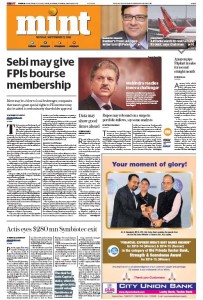Mint, a financial daily from HT Media Group, went from a Berliner to the larger Broadsheet format today.

Why did they do this?
Mint’s Executive Editor R Sukumar explained the change here. In the article he cites only one reason; that the earlier Berliner format was better suited to carrying longer in depth investigative pieces (“more of less” as he calls it). Today, he says, consumers prefer to get “more of more”, i.e., getting a complete range of news across all the issues that they track, for which a broadsheet format is better suited.
I am not really convinced. The Guardian is a Berliner, and nothing has stopped it from carrying more of more. Yes, the tabloid size in general does lend itself to fewer stories per page, and hence the need to make each story count. Popular tabloid size papers achieve this through sensationalizing the content, and provocative headlines, which have made the tabloid size synonymous with sensational news content. But that doesn’t mean every tabloid (or Berliner which are almost the same size) has to sensationalize content.
Size does matter, but i doubt size can influence news strategy as Sukumar puts it. Especially when the print paper is only one of many channels that connect to the consumer, the others being the website and the app. Given that most readers of Mint paper are also consuming content through the website, it makes sense to design one keeping the other in mind as well.
The tweets below sums up the confusion well.
I thought the Berliner was designed for a digital space
— K Yatish Rajawat (@yatishrajawat) September 12, 2016
congratulations! But what is the link between broadsheet format and digital news?
— Sharada (@suitcaseindian) September 12, 2016
what's the change? I figured this means the size of the print paper is different. What else?
— Nikhil Pahwa , https://mstdn.social/@nixxin (@nixxin) September 12, 2016
I think the real reason Mint went Broadsheet has nothing to do with news. Rather it has to do with advertising. And it isn’t even to do with pressure from advertisers.
Advertisers would never have seen the Mint’s smaller size as a challenge. Historically sizes mattered, as ad agencies had to resize content (positives as they were called) for a smaller sized paper. Thus if the prevalent pattern was broadsheet, it was rare for a new entrant to launch with a newer size, as agencies were reluctant to resize the artworks for you. Today though the material is all digital. So there is no real challenge with sizes.
Rather the pressure, I believe comes from a desire to bundle Mint and HT together; or rather to offer freebies to advertisers so that anyone taking ads in HT gets a free or almost free ad in Mint as well. Why do they want to do this?
The below is an educated guess. You may even call it speculation.
I think the reason HT Media is doing this is because it is looking to exit Mint.
Now ads have been falling in financial newspapers of late, and Mint is certainly feeling it. Naturally this impacts the price that they could command. If they are able to up the revenues, the greater the price that they will get (let us presume that earnings will grow with revenues). Hence I think the decision to resize Mint to the same size as HT. An advertiser buying an ad in HT will now get a 1+1 offer, giving him a same size ad in Mint and HT, for the price of an ad in HT. What is more, they can easily allocate x Rs from HT to Mint bumping up the revenues for Mint. It is just internal allocation after all.
Thus over a few years, they would have transferred X crores of value from HT to Mint, and more importantly, extract multiples of X in value from a buyer.
The above is really guesswork on my part. I would be very happy to be proved wrong.
Please note that I work for The Times of India Group. We compete with HT Media in several markets. I write this in my personal capacity, and haven’t consulted my employers before writing this.
